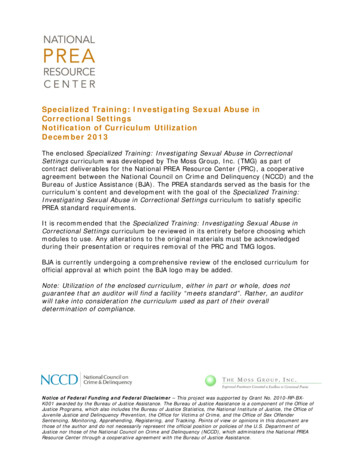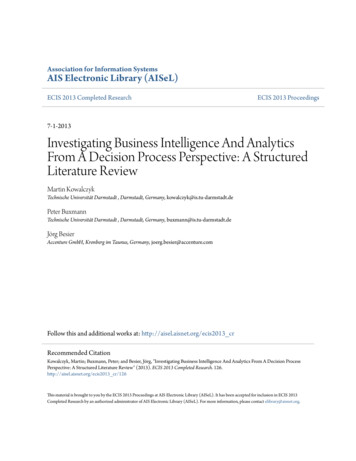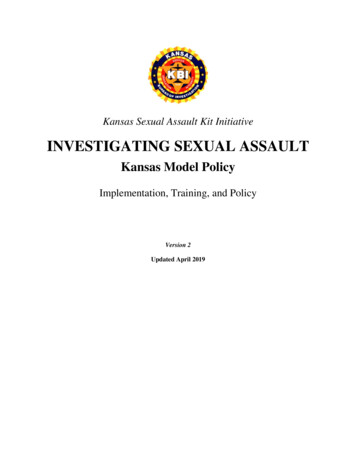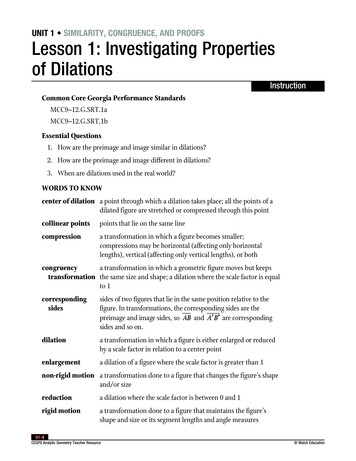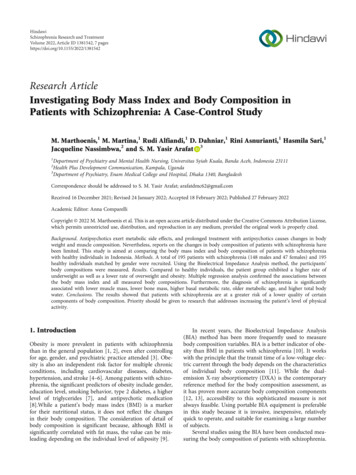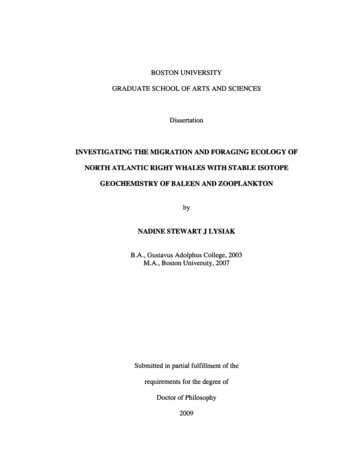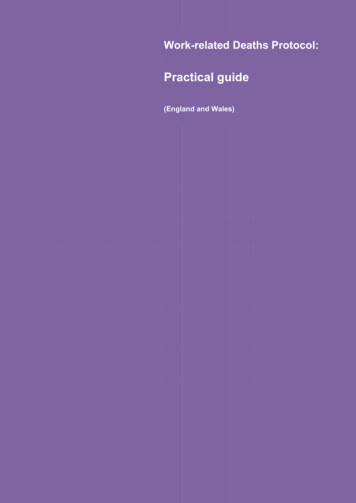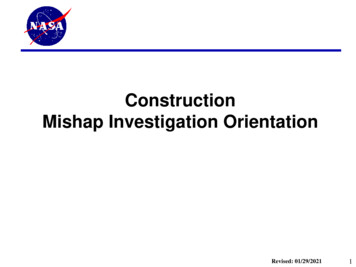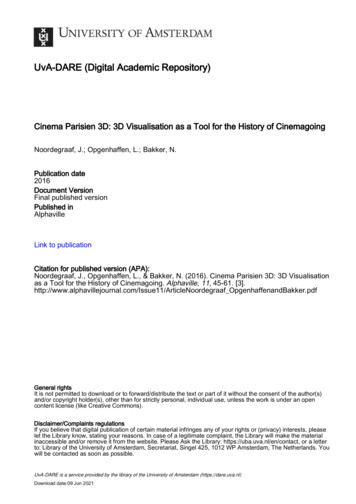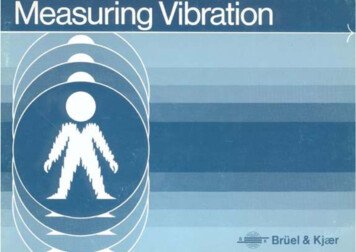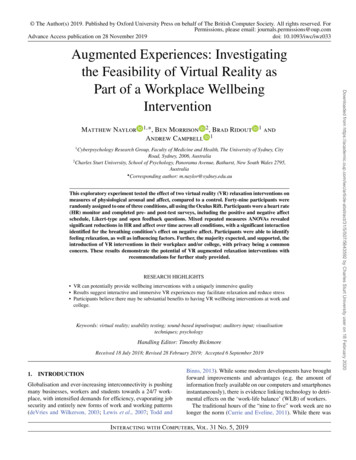
Transcription
The Author(s) 2019. Published by Oxford University Press on behalf of The British Computer Society. All rights reserved. ForPermissions, please email: journals.permissions@oup.comAdvance Access publication on 28 November 2019doi: 10.1093/iwc/iwz033Matthew Naylor1, *,Ben Morrison 2 , Brad RidoutAndrew Campbell 11and1Cyberpsychology Research Group, Faculty of Medicine and Health, The University of Sydney, CityRoad, Sydney, 2006, Australia2Charles Sturt University, School of Psychology, Panorama Avenue, Bathurst, New South Wales 2795,Australia Corresponding author: m.naylor@sydney.edu.auThis exploratory experiment tested the effect of two virtual reality (VR) relaxation interventions onmeasures of physiological arousal and affect, compared to a control. Forty-nine participants wererandomly assigned to one of three conditions, all using the Oculus Rift. Participants wore a heart rate(HR) monitor and completed pre- and post-test surveys, including the positive and negative affectschedule, Likert-type and open feedback questions. Mixed repeated measures ANOVAs revealedsignificant reductions in HR and affect over time across all conditions, with a significant interactionidentified for the breathing condition’s effect on negative affect. Participants were able to identifyfeeling relaxation, as well as influencing factors. Further, the majority expected, and supported, theintroduction of VR interventions in their workplace and/or college, with privacy being a commonconcern. These results demonstrate the potential of VR augmented relaxation interventions withrecommendations for further study provided.RESEARCH HIGHLIGHTS VR can potentially provide wellbeing interventions with a uniquely immersive quality Results suggest interactive and immersive VR experiences may facilitate relaxation and reduce stress Participants believe there may be substantial benefits to having VR wellbeing interventions at work andcollege.Keywords: virtual reality; usability testing; sound-based input/output; auditory input; visualisationtechniques; psychologyHandling Editor: Timothy BickmoreReceived 18 July 2018; Revised 28 February 2019; Accepted 6 September 20191.INTRODUCTIONGlobalisation and ever-increasing interconnectivity is pushingmany businesses, workers and students towards a 24/7 workplace, with intensified demands for efficiency, evaporating jobsecurity and entirely new forms of work and working patterns(deVries and Wilkerson, 2003; Lewis et al., 2007; Todd andBinns, 2013). While some modern developments have broughtforward improvements and advantages (e.g. the amount ofinformation freely available on our computers and smartphonesinstantaneously), there is evidence linking technology to detrimental effects on the ‘work-life balance’ (WLB) of workers.The traditional hours of the “nine to five” work week are nolonger the norm (Currie and Eveline, 2011). While there wasInteracting with Computers, Vol. 31 No. 5, 2019Downloaded from /507/5643592 by Charles Sturt University user on 18 February 2020Augmented Experiences: Investigatingthe Feasibility of Virtual Reality asPart of a Workplace WellbeingIntervention
508Matthew Naylor et al.reduction (Cooper and Cartwright, 1997; Murphy, 1984) andwellness maintenance, despite concerns that they only tacklethe consequences of work stressors rather than the sources(Cooper and Cartwright, 1997). Some examples of secondaryinterventions are health education and cardiovascular fitnessprograms for employees (Cooper and Cartwright, 1997),improved day care and flexible hours for caregivers (Yadav,2014) and improved or alternate routes for employees toexpress grievances or discontent (Beauregard, 2014). Whenappropriate, empirically-supported intervention strategies areimplemented in a work culture and climate that is supportiveof employees using them, there can be positive gains for theorganisation and employees (Smith and Gardner, 2007).One of the most universal workplace interventions is thebreak. Hunter and Wu (2015) describe several factors that leadto improved levels of post-break resources, such as preferencefor break activity and taking earlier, rather than later, breaks.They also provide evidence showing that workers feel less emotional exhaustion and more job satisfaction post-break. Thisresearch suggests that the relaxation that takes place during‘break time’ is a promising area to investigate.Relaxation and meditation techniques are found to be beneficial interventions for both clinical and sub-clinical psychological health and wellbeing (Ando et al., 2009; Arias et al., 2006).Such techniques can be passed on to a client without requiring agreat deal of training, with a goal of client self-practise. Clientsunable to attend regular relaxation sessions may also see benefitfrom an easy to learn ‘practise by yourself’ technique’, andthose who fear judgement in their workplace may be morelikely to take up a less overt intervention over traditionalemployee assistance programs. Given the benefits, it is prudentthen to examine easy to pick up relaxation techniques.An area of study that is showing potential for supportingwellbeing, and that allows for easy to pick up self-directedtechniques, is virtual reality (VR). Valmaggia et al. (2016) haveconducted an extensive systematic review of the use of VR inpsychological treatment, finding that on average, VR is at leastas effective as traditional treatments. A prior systematic reviewby Gonçalves et al. (2012) found that VR treatments for PTSDare at least as efficacious as traditional CBT. Anderson et al.(2013) also found that improvements shown by participantsundertaking a VR social anxiety treatment were maintained ata 12-month follow-up and were in line with benefits shownby participants who received group therapy instead. A recentpilot study trialling a Dialectical Behavioural Therapy (DBT)mindfulness skills training technique using VR found thatparticipants reported significantly less sadness, anger and anxiety, and were significantly more relaxed after using the VRtechnique for 10 minutes (Navarro-Haro et al., 2017). Otherclinical uses of VR investigated in recent years vary broadly intopics from the treatment of sexual assault survivors (Lorangerand Bouchard, 2017), to the recovery of stroke patients (Lohseet al., 2014). Such is the promise of VR therapy that thedevelopment of advanced tools is already being undertaken byInteracting with Computers, Vol. 31 No. 5, 2019Downloaded from /507/5643592 by Charles Sturt University user on 18 February 2020once an obvious spatial separation between “work”—a placefull of technical equipment, filing cabinets of documents orthe like—and “home”, devices like laptops bring most toolsof the trade to the living room along with the expectation ofcontinuous availability to work anywhere, anytime (Ladner,2008; Merecz and Andysz, 2014).There is now research highlighting WLB concerns in awide array of jobs and professions ranging from public sectoragencies (Todd and Binns, 2013), to education (Yadav, 2014),and online marketing (Ladner, 2008). Similar effects can beseen outside of employment, with tertiary students also beingvulnerable to the effects of poor WLB (Lovell et al., 2015).While not always the most influential factor, issues suchas long work hours and other work-related stressors are commonly found to be detrimental to subjective wellbeing (SWB).Indeed, in the Australian Psychological Society’s 2014 editionof the “Stress and wellbeing in Australia survey”, it was foundthat one-in-four Australians reported moderate-to-severe levelsof stress, with 44% of the 1020 respondents rating issues in theworkplace as a source of stress (Casey and Liang, 2014). This isin addition to a significant decline in participants’ satisfactionwith their WLB and overall workplace wellbeing, job interestand job satisfaction, compared to 2011 levels (Casey and Liang,2014). Lovell et al. (2015) found that tertiary students haddepression, anxiety and stress scores higher than the populationnorm, with 39.8% found to be at mild or higher on at least oneof the depression anxiety stress scales (DASS-21) subscales.Management and policy makers have shown an increasinginterest in WLB research in recent decades, as a result offactors including the increasing push for occupational healthand safety regulation (Cox et al., 2007), changing workforcecomposition and labour shortages (Todd and Binns, 2013).This is to say nothing of the desire to appear to be a modern, “caring organisation” in the public eye (Tehrani, 1994).Considering this, deVries and Wilkerson (2003) point out thatbecause mental (rather than physical) labour will be doingthe “heavy lifting” in the world of technology, mental healthmust be recognised as a business resource with greater breadththan simply productivity. Neglecting to properly nurture, thisresource can have a very high price to individual workers,e.g., burnout (Mamidenna and Viswanatham, 2014) and in turn,organisations, with per annum cost estimates of stress in theUSA ranging from 42 to 150 billion (Kalia, 2002).To minimise both the personal cost to employees and thefinancial costs to businesses, researchers and policy makershave turned to organisational level interventions for instigatingthe most efficient changes. There are three levels of intervention, which Murphy (1988) defines as primary (e.g. stressorreduction), secondary (e.g. stress management) and tertiary(e.g. employee assistance programs/workplace counselling). eorunfeasible, organisations will usually turn to secondary interventions.While often not the “first choice”, secondary interventionshave been found to play an important role in occupational stress
Feasibility of VR Workplace Interventions1.AIM AND RATIONALEGiven the potential for VR as a mindfulness meditation aid(Crescentini et al., 2016), its ease of use and ability to providea highly immersive and interactive experience (Valtchanovet al., 2010; Howard, 2018), the current study investigated thefeasibility of using VR in a break-time intervention aimed atimproving wellbeing in the workplace and at college. ‘SoundSelf’s’ interactive “augmented relaxation” design presents theopportunity to investigate whether an immersive VR experience, that is also interactive, can be an effective relaxationtechnique for improving wellbeing, compared to an immersive,but non-interactive, VR experience. Qualitative feedback on theuser experience will address a gap in the literature regardingthe suitability of VR interventions in the workplace, and helpinform and direct future directions in this area of study.2.RESEARCH QUESTIONS1. Is an interactive and immersive VR meditation experience more effective for promoting wellbeing, than anon-interactive, traditional guided breathing exercise,combined with an immersive VR visualisation display?2. Do either of these conditions significantly improve wellbeing compared to a non-interactive and non-immersivecontrol?3. What are participants’ understandings, expectations andbeliefs about the future of VR technology, as a foundation of relaxation interventions?3.3.1.METHODDesignThis exploratory study utilised a mixed methods design toexamine the effects of an interactive and immersive VR program designed to promote meditative relaxation, compared toa non-interactive traditional breathing exercise with immersiveVR elements, and a control (IVs), on participant heart rate (HR)and affect (DVs).3.2.ParticipantsForty-nine adult, non-clinical, volunteers (28 male, 21 female)were drawn from a convenience sample of college students andmembers of the general public. Recruitment efforts consistedof posting an invitation to participate on an in-college website,and snowball sampling via a social media page (Facebook),which was spread via word of mouth. Participation was subject to the following exclusion criteria: potential participantswith serious visual and/or auditory disabilities; conditions thatwould prohibit taking deep breaths; or any form of visuallytriggered epilepsy. Participants who met any of these criteriawere excluded on the basis of risk to the participant and/orconcerns about ability to complete the tasks required of theInteracting with Computers, Vol. 31 No. 5, 2019Downloaded from /507/5643592 by Charles Sturt University user on 18 February 2020authors such as Tartarisco et al. (2015), who tested a model toprovide clinicians with objective measures of user stress.While the study of VR as a mindfulness meditation aid is stilla developing one, there have been studies into the creation ofdedicated VR meditation software, for example Kosunen et al.(2016), which included neurofeedback as a feature. However,many of these kinds of programs are not easily available tothe general public, or require specialised equipment such as anelectroencephalogram device. Wellness maintenance beyondthe realm of clinical interventions has been examined for sometime now, with “positive computing” or “positive technology”proponents (e.g. Riva et al., 2012) advocating the examinationof how affective quality, engagement and connectedness canbe improved or introduced at core design levels of technology itself, rather than as an afterthought or separate product.Beyond clinical applications, VR is being studied in workplaces settings, for example Müller et al. (2017) simulated acollaborative hybrid task with a virtual robot collaborator in aVR workplace setting and investigated its impact on stress.VR interventions can bring something unique to the table: avery strong sense of ‘presence’ that limits distractions fromthe real world (Giglioli et al., 2015), resulting in a highlyimmersive experience (Howard, 2018; Valtchanov et al., 2010).The use of VR stress reduction interventions in workplacesis already starting to be explored in pilot studies such asAhmaniemi et al. (2017), who compared a series of VR natureexperiences to an audio only comparisons to test which had thegreater relaxing effect. It is important then that behavioural scientists and practitioners, working hand-in-hand with Human–Computer Interaction (HCI) experts, critically examine theunique potential of new technology-based VR tools, not onlyby using objective measures of stress reduction, but alsoby collecting qualitative feedback on the user experience toinform best-practice interventions. There is little point, afterall, to developing an objectively beneficial intervention ifyour target population cannot, or will not, take advantageof it.One recent example of the combination of VR technologyand relaxation is the program ‘SoundSelf’, created by Arnottand Balster (2015a). Inspired by traditional meditationand mind-altering experiences, ‘SoundSelf’ was createdspecifically as an interactive meditation-aid VR experience.‘SoundSelf’ allows a user to interact with and changethe ‘tunnels-of-light’ and ‘impossible shapes or patterns’that appear on the display, either by voicing differentsustained tones/sounds/chants, or by being silent. Thisstyle of chant-based meditation has its roots in traditionssuch as Buddhist and Hindu techniques and is suggestedby Arnott to aid introspection and facilitate a mindfulness experience (Arnott and Balster, 2015b). ‘SoundSelf’sease of use and simple immersive and interactive designmeans it has potential to be a useful example of a consumer relaxation tool, however, it has yet to be empiricallytested.509
510Matthew Naylor et al.3.3.FIGURE 1. Screenshot from the ‘SoundSelf’ condition.MaterialsAll sessions took place in a spare office located within theadministration area of the college and were finished with every day office furniture. An Oculus RiftTM Development Kit2 (Oculus VR, LLC, Menlo Park, CA, USA) was used inall conditions, in conjunction with a Windows 7 laptop. The‘SoundSelf’ condition (see Fig. 1 for a visual example) useda 20-minute version of the interactive and immersive meditation program of the same name (SoundSelf alpha build2015-06-10). The breathing condition (see Fig. 2) used theaudio component of a guided breathing exercise from Curasmile YouTube channel (2013) “relaxation breathing guided”,that had been edited in-house, so that it was 20 minutes induration. This was combined with visuals generated usingVisiR (version 0.7.5) from Valynx Studio (2015), to createan immersive, but not interactive, experience. This programcreated visuals that changed colour and pattern in responseto the paired audio (rather than controlled by user input) tocreate a visual experience of a comparable nature to what can befound in ‘SoundSelf’ (i.e. both programs involve the user beingimmersed in a void of colourful lights and sound). Participantsin the control condition were shown a portion of the “Rainy DayOffice Window” video from Jason Comerford PhotographyYouTube channel (2015), that had been edited in-house, so thatit was 20 minutes in duration (see Fig. 3). The video featureda fixed position 2D view focusing on a tree and its leaves on arainy day, with a streetscape background. This condition waschosen as it involved participants wearing the same VR setupand being exposed to a relaxing experience (comparable toValtchanov et al., 2010), without the immersive or interactiveVR aspect. HR was monitored using a Fitbit Charge HRTM (Fitbit Inc.,San Francisco, CA, USA) wearable wireless activity tracker(comparable with Main et al., 2017). HR tracking was important to include as it provides an objective measure of participantarousal during the experiment (Chlan, 1998; Crescentini et al.,2016; Kao et al., 2014). Data points were generated in the formof average HR over each five-minute segment.Participants were asked to complete pre- and post-test surveys. The pre-test survey contained simple demographic ques-FIGURE 2. Screenshot from the breathing condition.FIGURE 3. Screenshot from the control condition.tions (e.g. age, gender), as well as the positive and negativeaffect schedule (PANAS; Watson et al., 1988). The PANAS isone of the most widely cited and diversely used inventories ofits kind (Harmon-Jones et al., 2009). Along with providing normative data, the PANAS reports reliability scores of α 0.80for both the positive affect (PA) and negative affect (NA) scales,and significant stability in scores even in “moment-to-moment”ratings (Watson et al., 1988). The PANAS was used to measurechanges in participant affect, as a signifier of relaxation. AStroop test was adapted based on the original design by Stroop(1935), using the colours red, blue, green, brown and purpleto create an ordered table of 100 answers in tandem with aPowerPoint presentation. The test (i.e. the PowerPoint presentation) itself, was controlled entirely by the investigator: theparticipant was only required to respond verbally to this task.The use of the Stroop test here warrants further explanation:instead of being used as a diagnostic measure (e.g. examiningInteracting with Computers, Vol. 31 No. 5, 2019Downloaded from /507/5643592 by Charles Sturt University user on 18 February 2020study. Those under the age of 18 were also excluded due tothe population of interest being adults.Participants who did not meet exclusion criteria were thenrandomly assigned to one of three groups: 16 (11 male and5 female) in the ‘SoundSelf’ condition, 16 (6 male and 10female) in the breathing condition and 17 (11 male and 6female) in the control condition. Participant ages ranged from18 to 50 with a mean age of 27.33 (SD 6.96) and a medianage of 26. The mean age for males was 29.43 (SD 7.91) and24.52 (SD 4. 17) for females, with median ages of 28 and 24,respectively.
Feasibility of VR Workplace Interventions3.4.ProcedureEach experimental session was conducted by a single investigator in the same office, using the same equipment. All studiestook place during weekdays between the times of 11:00 am and05:00 pm. In all cases, the time spent using the Oculus Riftwas strictly kept to 20 minutes. Each participant was seatedin an office chair and fitted with the Fitbit activity trackingdevice and asked to complete the pre-test self-report surveys ona computer. These surveys were hosted online and accessed viaa standard internet browser. Once the survey was completed,participants were asked to complete the PowerPoint-basedStroop test.Participants were then randomly allocated into one of thethree experimental conditions: the ‘SoundSelf’ condition,the breathing condition or the control condition. Participantswere not made aware of this selection, or the existence ofalternate conditions, until after the experiment. Participantswere given a short general briefing on how to comfortablyand safely use the Oculus Rift (e.g. “you do not have tosit completely still, you may look around”) before beinggiven specific guidance and tips for their selected condition.To ensure greater reliability, all guidance and instructionwas based on a script prepared by the authors, however,to avoid an overly artificial experience for the participants,it was not followed verbatim. Participants were fitted withthe Oculus Rift headset and headphones by the investigator,and then used the Oculus Rift for the 20-minute durationof their assigned condition while their HR continued tobe recorded. The investigator waited outside the room togive participants privacy for the duration of the conditioncomponent.At the end of the 20-minute session, the investigator returnedand removed the Oculus Rift and headphones from the participant. Each participant was then asked to complete the post-testonline inventory while continuing to wear the Fitbit. Once theparticipant had completed the post-test survey, the Fitbit wasremoved by the investigator and the participant was debriefedon the experiment.3.5.Statement of ethics complianceApproval from the Human Research and Ethics Committee(HREC) was sought and granted (approval #222040615).All participants gave written consent to take part in theexperiment.4.4.1.RESULTSPhysiological arousal (heart rate)Averages of participant HR data points were taken for thethree parts of the experiment: the pre-test (including the Strooptask), during the intervention (test) and post-test. They werethen analysed using a 3 (condition) 3 (time) mixed repeatedmeasures ANOVAs (α 0.05) with intervention condition asthe between-groups factor with three levels: the ‘SoundSelf’condition (n 16), the breathing condition (n 16) and thecontrol condition (n 17).A significant main effect was identified for the differences inHR means across time, as shown in Table 1, with a large effectsize of ηp 2 0.57. This suggests that participant HR changedover time in a way that was consistent across all conditions,and that the change in HR was not dependent on belonging to aspecific condition. Mauchly’s test of Sphericity returned a nonsignificant value of W 0.950 (2), P 0.317, indicating thatthe assumption of equal variances was not violated.Pairwise comparisons using a Bonferroni correction for familywise error rate (α 0.05) revealed a significant decrease inHR at pre-test (M 85.70, SD 12.53) compared to during theintervention (M 78.75, SD 11.93), t(46) 9.99, P 0.001,R2 0.68, and between pre-test (M 85.70, SD 12.53) andpost-test (M 78.45, SD 10.58), t(46) 8.75, P 0.001,R2 0.62. There was no significant difference in mean HRrecorded during the intervention compared to post-test.4.2.Affect (PANAS)Participant scores on the PANAS were obtained during preand post-test surveys and were then analysed for each subscaleusing two separate 2 (time) 3 (condition) mixed repeatedmeasure ANOVAs (α 0.05). The intervention conditionwas between groups factor with three levels: the ‘SoundSelf’condition (n 16), the breathing condition (n 16) and thecontrol condition (n 17).Interacting with Computers, Vol. 31 No. 5, 2019Downloaded from /507/5643592 by Charles Sturt University user on 18 February 2020attention or executive function) the Stroop test provided aninitial “stressed” pre-test HR benchmark to better examine theeffect of the experimental manipulations (similarly used in Kaoet al., 2014; Reinhardt et al., 2012). The results of the Strooptest (i.e. number of correct responses within the 2-minute timelimit) were given to each participant, but were not analysed dueto the test only serving the function of a stressor.The post-test survey contained several Likert-type andopen-response qualitative questions composed in-house bythe authors, asking participants how they felt after usingthe Oculus Rift (compared to how they felt beforehand),as well as usability-related queries and the use of VR inworkplaces and other applications (see online supplementalmaterial for wording of qualitative questions). The PANASwas included a second time for the post-test, however, theinstructions were modified to ask participants to considerthe time from the start of the VR experience until the present. All surveys were hosted online using Qualtrics(Qualtrics LLC, Provo, UT, USA) with all data analysedusing IBM SPSS (Version 23.0 for Windows; SPSS Inc.,Chicago, IL, USA).511
512Matthew Naylor et al.TABLE 1. Summary of ANOVA results for HR.TestEffectdfFPηp 2Heart rateTimeConditionTime condition 22459.902.311.86 0.570.090.080.110.12TABLE 2. Summary of ANOVA results for PANAS.TestSubscaleEffectdfFPηp 2PANASPositiveTimeConditionTime condition TimeConditionTime condition 12212211.851.371.7014.261.465.60 0.210.060.070.240.060.20Negative0.260.19 0.24 P 0.05, P 0.01, P 0.001.Positive affect (PA)A significant moderate main effect (ηp 2 0.21) was found fortime and can be seen in Table 2. This suggests that taking partin any condition resulted in a significant reduction in reportedPA scores from pre-test (M 28.67; SD 7.37) to post-test(M 25.02; SD 7.94).4.2.1.Negative affect (NA)As can be seen in Table 2, a significant main effect was foundfor time. This suggests that, holding the effect of condition constant, there was a significant reduction in reported NA betweenpre-test (M 13.45; SD 2.61) and post-test (M 11.76;SD 2.98). An interaction effect of moderate (ηp 2 0.20) sizewas identified between condition and time for NA and exploredusing tests of simple effects, using a Bonferroni correction forfamilywise error rate (α 0.05). A significant reduction wasfound between pre-test (M 14.56; SD 3.41) and post-test(M 10.75; SD 1.39) means for the breathing condition,Wilk’s λ 0.664, F(1, 46) 23.24, P 0.001, ηp 2 0.34,but not for the ‘SoundSelf’ or control condition.4.2.2.Frequencies and qualitative questions4.2.3.1. Responses describing participants’ subjective feelingsof relaxation. Upon finishing the 20-minute intervention,participants were asked an open-ended question regarding theirexperience, in order to gauge their first impressions before theywere exposed to any other questions. Common responses wereidentified using a thematic analysis and combined into themes(see Table 3).When asked directly to compare how they were feelingbefore using the Oculus Rift to the present, 44 (89.80%) participants described feeling either slightly or much more relaxed,with only two (4.08%) feeling slightly more stressed after the4.2.3.intervention (Table 4). Broader subjective responses regardingrelaxation provided similar results, with 14 (28.57%) responsesindicating themes describing “Mixed or small amount of relaxation” and 31 (63.27%) reporting confirmed feelings of relaxation after the intervention (Table 5).When examining for any feedback that indicated a possibledetriment to a participant’s ability to relax, two questions werepresented: one asking explicitly about any stimuli or parts ofthe intervention that made participants feel like they wanted toclose their eyes, and one more general and open-ended questionabout any negative influences. The results of these questionshave been combined in Table 6.Participants were given the chance to comment on what, ifany, changes they felt could be made to the intervention theyexperienced to improve relaxation. Several different areas forpossible improvement were identified, including a subthemethat developed around the importance of pairing the right styleof intervention with the right client and giving users the abilityto exercise their preferences (see Table 7).4.2.3.2. Responses describing participant expectations for thefuture. Several Likert-type questions were presented askingparticipants about their thoughts on the future use of VR andsimilar technologies. Participants were asked about the valueof developing 20-minute wellbeing interventions that couldbe used at work or college, with 31 (63.27%) participantsbelieving it is an area worth developing, and three (6.12%)expressly disagreeing. Response frequencies can be found inTable 8 below.When asked if they would take up the offer of a free20–30 minute VR relaxation intervention if it was offeredat their workplace or college, 29 (59.18%) participants saidyes. This support jumped to 42 (85.71%) if concerns such asInteracting with Computers, Vol. 31 No. 5, 2019Downloaded from /507/5643592 by Charles Sturt University user on 18 February 2020 P 0.05, P 0.01, P 0.001.
Feasibility of VR Workplace Interventions513TABLE 3. Themes and frequencies for the “first impressions” 78%43.75%56.25%64.71%55.10%37.50%
2Charles Sturt University, School of Psychology, Panorama Avenue, Bathurst, New South Wales 2795, Australia Corresponding author: m.naylor@sydney.edu.au This exploratory experiment tested the effect of two virtual reality (VR) relaxation interventions on measures of physiological arousal and affect, compared to a control. Forty-nine .
